Columbjohn
Columb John (today "Columbjohn") in the parish of Broadclyst in Devon, England, is an historic estate and was briefly the seat of the prominent Acland family which later moved to the adjacent estate of Killerton. Nothing of the structure of the Acland mansion house survives except the arch to the gatehouse, dated about 1590,[1] and the private chapel, restored in 1851. The site of the former mansion house is situated one mile due west of Killerton House, and five miles north-east of the historic centre of the City of Exeter. The estate's name derives from it having been held by the Culme family, whose own name was taken from its landholdings in the vicinity of the River Culm,[2] which flows through the Columb John estate.
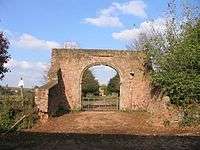

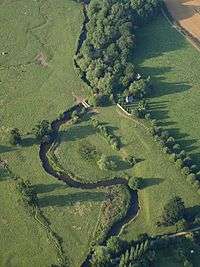
Descent
Fulchere
The Devon Domesday Book tenant-in-chief of Colum in 1068 was Fulchere, also known as "Fulchere the Bowman", one of the king's lesser tenants. He held it in demesne. Most of his seven holdings listed in the Domesday Book later passed to the feudal barony of Plympton,[3] of which the lords were later the Courtenay Earls of Devon.
Culme
The Culme family name was taken from its landholdings in the vicinity of the River Culm,[2] which flows through the Columb John estate. A branch of the Culme family was later seated at Molland Champson in North Devon. The descent of the estate in the de Culm family is given by Pole (d.1635) as follows:
- Walter de Culm[2]
- John I de Culm, son.[2] A "John de Culum" is listed in the Book of Fees as holding the estate from William Brewer (d.1226), and at another time from the feudal barony of Plympton.[5]
- John II de Culm (fl.1233), son[2]
Clifford
.svg.png)
- The estate was subsequently held by Reginald de Clifford, whose tenants included:
St Aubyn
In 1295 Clifford St Aubyn and Sir Mauger St Aubyn were tenants of Columb John under the Clifford family.[2]
de Bere
In 1314 Columb John was held by Sir Gilbert de Bere, in right of his wife Isabell[2] Clifford, daughter of Roger Clifford.[8]
Prideaux
The Prideaux family is believed to be of Norman origin and to have first settled in England at some time after the Norman Conquest of 1066 at Prideaux Castle, near Fowey, in Cornwall. It abandoned that seat and moved to Devon, where it spread out in various branches, most notably at Orcharton, Modbury; Adeston, Holbeton; Thuborough, Sutcombe; Solden, Holsworthy; Netherton, Farway; Ashburton; Nutwell, Woodbury and Ford Abbey, Thorncombe.[10] Another branch built Prideaux Place in Cornwall in 1592, where it survives today. It was one of the most widespread and successful of all the gentry families of Devon, and as remarked upon by Swete (d.1821), exceptionally most of the expansion was performed by younger sons, who by the custom of primogeniture were expected to make their own fortunes.[11]
- Sir Roger Prideaux, of Orcharton in the parish of Modbury, Devon, who held Columb John in 1345, having inherited it by marriage to his step-sister Elizabeth de Clifford, daughter and heiress of Sir John Clifford[2] (fl.1324) of Combe-in-Teignhead,[12][13] Devon, by his wife a certain Claricia (d.1349), who married secondly Sir Roger de Pridias (Prideaux) (1294-pre-1357), Member of Parliament for Devon in 1331.[14] Sir Roger Prideaux was the eldest son and heir of Sir Roger de Pridias (Prideaux) (1294-pre-1357), Member of Parliament for Devon in 1331,[14] by his wife Elizabeth de Treverbyn, a daughter and co-heiress of Hugh de Treverbyn[15] of Treverbyn in the parish of St Austell in Cornwall.
- Sir John Prideaux (c.1347-1403), son,[16] of Orcharton, Member of Parliament for Devon in 1383 and 1387.[17] He granted the estate of Columb John to the Earl of Devon.[2]
Courtenay
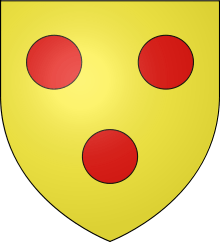
The Courtenay Earls of Devon, of Tiverton Castle, acquired the estate from Sir John Prideaux.
- "Edward, Earl of Devon" (according to Pole, probably therefore Edward de Courtenay, 3rd/11th Earl of Devon (1357–1419), "The Blind")[2] or "Hugh Courtenay, Earl of Devon" (according to Risdon, therefore probably Hugh de Courtenay, 4th/12th Earl of Devon (1389–1422))[16] granted the estate to Richard Bampfield (d.1430), a younger member of the Bampfield family of Poltimore and of North Molton in Devon.[2]
Bampfield
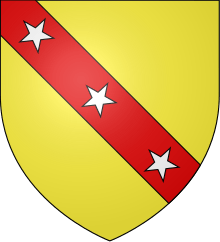
- Richard Bampfield (d.1430) received a grant of the estate to himself and "the heirs male of his body", from "Edward, Earl of Devon".[2] He was the second son of Thomas II Bampfield,[18] lord of the manor of Poltimore, Devon, by his wife Agnes Faber, daughter and co-heiress of John Faber. He died without male progeny, and thus the estate escheated to Thomas de Courtenay, 5th/13th Earl of Devon (1414–1458).[2]
Courtenay
- Thomas Courtenay, Earl of Devon, who as feudal overlord received the escheat of the estate following the death without male progeny of Richard Bampfield (d.1430)[2]
- Henry Courtenay, 1st Marquess of Exeter (1538), the last holder, whose vast estates were forfeited to the crown following his attainder and execution in 1538.[2]
Basset
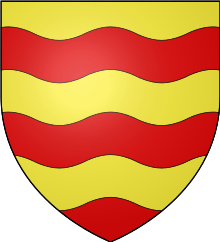
- George Basset (c.1524-c.1580), of Tehidy in the parish of Illogan, near Redruth in Cornwall, to whom the estate was granted by the crown following the 1538 attainder of Henry Courtenay, 1st Marquess of Exeter. He was the second son of Sir John Basset (1462–1528)[2] (1462-1528) of Umberleigh and of Heanton Punchardon in Devon, by his second wife Honor Grenville, later the wife of Arthur Plantagenet, Viscount Lisle (d.1542), KG (an illegitimate son of King Edward IV, half-brother of Queen Elizabeth of York, and thus an uncle of King Henry VIII), whose natural half-sister was Catherine of York (1479-1527), wife of William Courtenay, 1st Earl of Devon and mother of Henry Courtenay, 1st Marquess of Exeter.
- Phillip Basset, son, who sold it to William Rowswell.[2]
Rowswell
- "William Rowswell", who acquired the estate from Phillip Basset.[2] He sold it to Sir John Acland. He was possibly William Rosewell(1561–1593), son of William Rosewell (c. 1520–1566), Solicitor-General 1559-1566, who possessed several estates in Devon, many purchased from those who had acquired them at the Dissolution of the Monasteries. At the time of his death in 1566 the elder William held the manors of Ermington and Carswell (Broadhembury) in Devon and the manors of Southbrent (Brent Knoll), Stapleton, Limington and Alford, in Somerset.[19]
Acland
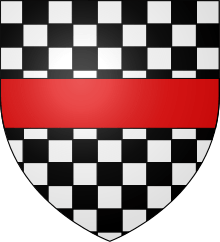
Sir John Acland (c.1552-1620)
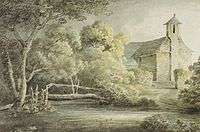
Sir John Acland (c.1552-1620) landowner, philanthropist, Member of Parliament and Sheriff of Devon. He was one of John Prince's Worthies of Devon. He was the second son of John Acland (d.1553), of Acland in the parish of Landkey, Devon, by his wife Mary Redcliff, daughter and co-heiress of Hugh Redcliff of Stepney near London. From before 1155 the Acland family had been seated at the estate of Acland, from which it took its name,[20] originally de Acland.[21] In the opinion of Hoskins (1981), based on its early and repeated use of the Flemish firstname of Baldwin, the Acland family probably migrated to England from Flanders soon after the Norman Conquest[22] of 1066. It was in the late 20th century probably the oldest surviving landed family in Devon, which by the 19th century possessed a huge estate in the West Country of almost 40,000 acres.[23]
Sir John Acland (d. 1620) acquired the estate from William Rowswell and on the foundation of a building commenced by one of the Courtenays, built there "a very fayre howse" (Pole). He also built next to it a private chapel which he endowed with an unalienable endowment of £25 per annum for ever "for the encouragement of a chaplain to preach and read prayers in it every Sabbath day".[24] The chapel survives today having been restored or rebuilt in 1851, called "St John's Chapel",[25] a grade II listed building.[26] He married twice, but left no surviving progeny, and at his death his heir was his elder brother Hugh Acland (c.1543–1622) of Acland.
Hugh Acland (c.1543–1622)
Hugh Acland (c.1543–1622) (elder brother & heir) of Acland, Sheriff of Devon in 1611. At the age of about 70 he became heir to his wealthy and childless younger brother, Sir John Acland of Columb John. He was buried in Landkey Church on 22 May 1622.[27] He married Margaret Monke (died 1619), a daughter of Thomas Monke of Potheridge, Merton in Devon, great-grandfather of George Monck, 1st Duke of Albemarle (1608–1670).[28] Thomas Monke's first wife and Margaret's mother was Frances Plantagenet, a daughter of Arthur Plantagenet, 1st Viscount Lisle[29] (died 1542) an illegitimate son of King Edward IV half-brother of Queen Elizabeth of York, and thus an uncle of King Henry VIII, at whose court he was a prominent figure. He was thus a natural half-brother of Catherine of York (1479-1527), the wife of William Courtenay, 1st Earl of Devon. Lisle had become connected with Devon following his 2nd marriage to Honor Grenville a Devonshire lady whose first husband had been Sir John Bassett,[30] (1462–1529) of Umberleigh, Devon, 4 1/2 miles due south of Acland. He was predeceased by his eldest son and heir, Sir Arthur Acland (d. 1610), who therefore never inherited Acland, but who was granted by his father the estate of Columb John, which became the jointure of his widow Eleanor Mallet.
Sir Arthur Acland (d. 1610)
Sir Arthur Acland (died 1610) (eldest son and heir) whose impressive monument with effigy and inscription survives in the Acland Aisle in Landkey Church. Little is known about his life and career. Arthur Acland married his step-first cousin Eleanor Mallet (1573–1645),[27] a daughter and co-heiress of Robert Mallet of Wooleigh,[27] in the parish of Beaford,[31] near Great Torrington,[32] Devon. Wooleigh adjoins Potheridge, separated by the River Torridge. Eleanor's mother (or step-mother) was Elizabeth Rolle (a daughter of George Rolle (died 1552) of Stevenstone, the founder of a Devonshire land-owning dynasty even greater than the Aclands), who remarried to Sir John Acland (died 1620) of Columb John, Sir Arthur's uncle. Eleanor survived Sir Arthur and remarried to Sir Francis Vincent, 1st Baronet[27] (c. 1568 – 1640) of Stoke d'Abernon,[33] in Surrey. Columbjohn was at some time occupied by a connection of Eleanor Mallet, namely Antony Harvey, "an expert surveyor",[34] the maternal grandfather of Eleanor Mallet's second husband's first wife Sarah Paulet, a daughter of Sir Amias Paulet (1532 – 26 September 1588) of Hinton St. George, Somerset, Governor of Jersey.
Sir John Acland, 1st Baronet (d.1647)
Sir John Acland, 1st Baronet (d.1647) of Acland, son, who abandoned the ancient family seat of Acland in favour of Columb John, which he had inherited from his great-uncle Sir John Acland (d.1620). He purchased the estate of Killerton, adjoining Columb John, as a jointure for his widowed mother Eleanor Mallet, who lived there with her second husband Sir Francis Vincent.[35] John Acland was a Royalist commander in the Civil War. Before the start of the War he was appointed by King Charles I as one of 28 Commissioners of Array for Devon, in which role he raised two regiments for the King. The mansion house served as a garrison for Royalist troops, and played a key role for that side as described by Clarendon in his History of the Rebellion:[36]
- "Devonshire was left in a very unsafe posture: there being only a small party at Columb-John, a house of sir John Ackland's, three miles off Exeter, to control the power of that city, where the Earl of Stamford was; and to dispute not only with any commotion that might happen in the country, but with any power that might arrive by sea".
The Royalist position improved in 1643 and Columb John ceased to be an isolated Royalist outpost when Prince Maurice and his army reached the area in the summer of that year.[37] It was probably in recognition of his service in providing a Royalist garrison that Acland was awarded a baronetcy, of Columb John in the County of Devonshire", and was appointed Sheriff of Devon, by King Charles I in 1644.[38] In 1645 Sir John was one of those present in the City of Exeter during the siege by Parliamentarian forces commanded by Generals Cromwell and Fairfax, who made Columb John their headquarters during the siege. The Parliamentarian troops were " a civilised lot, who paid for what they took, and ... knew how to behave like gentlemen even to their enemies. Sir John Acland's wife wrote to Cromwell as follows: "I received such ample testimony of your love when you were pleased to quarter at my house as that I cannot sufficiently express my thankfulness for the same".[38] Whilst quartered at Columb John Cromwell and Fairfax offered very reasonable terms to the City that it surrendered on 13 April 1646 and all civilians and soldiers, including Sir John Acland, were permitted to march out honourably with colours flying, provided they laid down arms and took the national covenant of loyalty to Parliament. Acland was fined heavily for his delinquency, at £1,727 (later tripled) a sum equivalent to 1/10th of the value of his estates, which was the fourth largest fine suffered in Devon.[39] Upon his death in 1647, he was succeeded by his eldest son Sir Francis Acland, 2nd Baronet (d. 1648).
Sir Francis Acland, 2nd Baronet (d. 1648)
Sir Francis Acland, 2nd Baronet (d. 1648), eldest son, who survived his father only a short time. He died unmarried and was buried at Stoke D'Abernon in Surrey, the former St Vincent manor, and his ledger stone survives in that church.
Sir John Acland, 3rd Baronet (d. 1655)
Sir John Acland, 3rd Baronet (d. 1655), younger brother. In 1654, he married Margaret Rolle, daughter of Denys Rolle (1614–1638) of Stevenstone.
Sir Arthur Acland, 4th Baronet (1655–1672)
Sir Arthur Acland, 4th Baronet (1655–1672), only son and heir who died as a minor in 1672, unmarried, and was succeeded by his uncle Hugh.
Sir Hugh Acland, 5th Baronet (died 1714)
Sir Hugh Acland, 5th Baronet (died 1714), uncle, who demolished the mansion house at Columb John and made adjacent Killerton his principal seat, which house he enlarged, possibly using some of the stonework from Columb John.[40] Columb John thus became merged into the estate of Killerton. He retained only the chapel at Columb John, possibly because it had been endowed by Sir John Acland (d.1620) with an unalienable endowment of £25 per annum for ever "for the encouragement of a chaplain to preach and read prayers in it every Sabbath day".[24] He gave it a new silver chalice to replace one lost during the Civil War.[40] The chapel was restored in 1851 by Arthur Henry Dyke Acland (1811-1857) of Huntsham, Devon, who adopted the additional surname of Troyte in accordance with the will of his distant cousin by marriage Rev. Edward Berkeley Troyte, lord of the manor of Huntsham.[41] He was a younger brother of Sir Thomas Dyke Acland, 11th Baronet (1809–1898), of Killerton.[42] The building survives today as the "Chapel of St John".[25]
Further reading
- Gray, Todd & Rowe, Margery (Eds.), Travels in Georgian Devon: The Illustrated Journals of The Reverend John Swete, 1789-1800, 4 vols., Tiverton, 1999, vol.4, pp. 210–11
Sources
- Pole, Sir William (d.1635), Collections Towards a Description of the County of Devon, Sir John-William de la Pole (ed.), London, 1791, pp. 170–1 Columb John
- Risdon, Tristram (d.1640), Survey of Devon, 1811 edition, London, 1811, with 1810 Additions, p. 59, Columb-John
- Acland, Anne. A Devon Family: The Story of the Aclands. London and Chichester: Phillimore, 1981
References
- Pevsner, Nikolaus & Cherry, Bridget, The Buildings of England: Devon, London, 2004, p.279
- Pole, p.170
- Thorn, Caroline & Frank, (eds.) Domesday Book, (Morris, John, gen.ed.) Vol. 9, Devon, Parts 1 & 2, Phillimore Press, Chichester, 1985, part 2 (notes), ch.49
- Pole, p.476
- Thorn & Thorn, part 2 (notes), ch.49:2
- Pole, p.478
- Vivian, p.194, pedigree of Clifford of Chudleigh, note to entry for Roger de Clifford of Tenbury (d.1231), second son of Walter II de Clifford (c. 1160 – 17 January 1221), feudal baron of Clifford of Clifford Castle in Herefordshire
- Risdon, p.569
- Vivian, Heraldic Visitations of Devon, p. 616
- Vivian, Lt.Col. J.L., (Ed.) The Visitations of the County of Devon: Comprising the Heralds' Visitations of 1531, 1564 & 1620, Exeter, 1895, pp.616-25, pedigree of Prideaux
- Gray, Todd & Rowe, Margery (Eds.), Travels in Georgian Devon: The Illustrated Journals of The Reverend John Swete, 1789-1800, 4 vols., Tiverton, 1999, vol.2, p.107
- Pole, pp.248-9 "Combe in Tinhed"
- http://www.historyofparliamentonline.org/volume/1386-1421/member/prideaux-sir-john-1347-1403
- Vivian, p.616, pedigree of Prideaux
- Vivian, p.616
- Risdon, p.59
- Vivian, p.617; see also his History of Parliament biography
- Vivian, p.38, pedigree of Bampfield
- http://www.tudorplace.com.ar/Documents/solicitor_general.htm
- Hoskins, W.G., A New Survey of England: Devon, London, 1959 (first published 1954), p.422
- Acland, Anne, p.2 & foreword by W H Hoskins
- Acland, Anne, p.2; & foreword by W H Hoskins, p.xv
- Acland, Anne, foreword by W H Hoskins, p.xv, xvi
- Swete, Vol.4, p.211
- Pevsner, p.279
- Listed building text
- Vivian, p.4
- Vivian, p.569, pedigree of Monk of Potheridge
- Vivian, p.569, pedigree of Monk
- Vivian, p.47, pedigree of Basset
- Hoskins, p.330;Mallet family website
- Prince, p.2 "Woolley"; today's "Wooleigh Barton", about 3 miles SE of Great Torrington
- Per monumental inscription, Landkey
- Pole, p.171
- Acland, Anne, p.6
- Acland, Anne, p.7
- Acland, Anne, p.9
- Acland, Anne, p.10
- Acland, Anne, p.13
- Acland, Anne, pp92-3, 156
- Acland, Anne, pp91-2